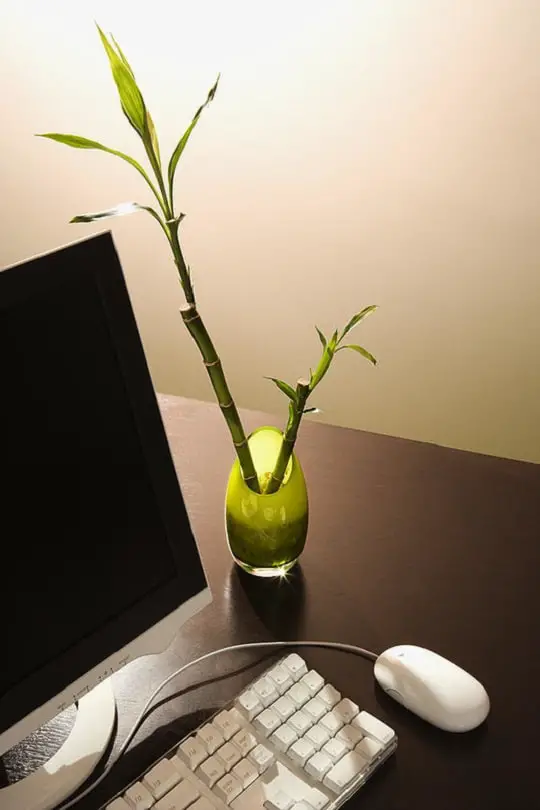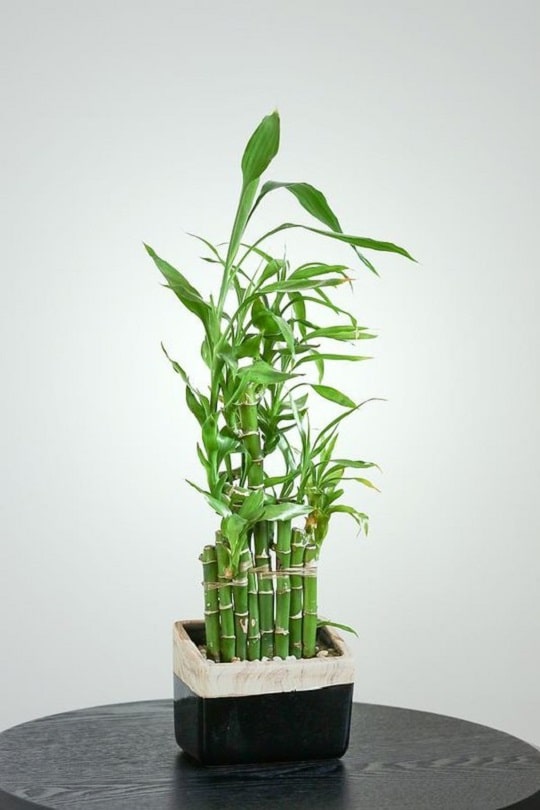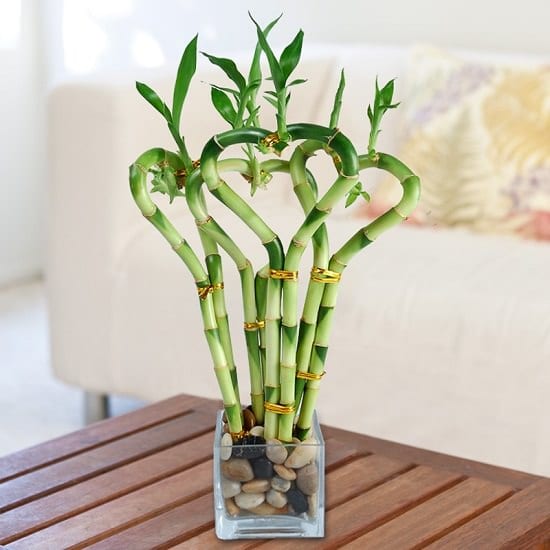Discover these Lucky Bamboo Care Tips to learn how to grow this low care houseplant. It’s perfect for your office desk, kitchen counter, or as a tabletop centerpiece!
Botanical Name: Dracaena sanderiana
Common Names: Chinese water bamboo, Sander’s dracaena, ribbon dracaena, ribbon plant, lucky bamboo, curly bamboo, Goddess of Mercy’s plant, and Belgian evergreen
Lucky bamboo is native to central Africa and belongs to the family Asparagaceae. You’ll be surprised to know that it’s not bamboo at all and in fact, it’s a tropical water lily. It’s considered to bring good fortune in Feng Shui, in many Asian countries, and that’s why it’s a popular houseplant and also gifted on many occasions.
Also Read: 14 Positive Energy Plants for Offices
How to Grow Lucky Bamboo
Being a hydroponic plant, it can grow solely in water without the need for any other medium like soil. It depends on you, whether you want to have it in soil or water. Let’s discuss both in brief.
Container Choice
You can grow it in small decorative pots and vases of your choice. However, very shallow containers won’t be able to support this plant, so it’s important for the container to be tall–At least covering the 1/2 or 1/3 height of your existing lucky bamboo plant.
When it comes to the material, you can go for both clear glass vases and ceramic pots. Both have their own set of advantages in disadvantages.
When it comes to appearance, the glass vase steals the show with clean water and decorative stones. Also, it’s convenient to check the water level in a glass vase.
Although algae might grow in a clear container if you won’t change the water much, so the colored container is another choice to go for. All in all, it depends on what suits your needs!
Growing Lucky Bamboo in Soil
Location: The plant will do best in bright indirect sunlight. So, if you keep it on the window, make sure to avoid exposure to direct light as it can scorch the leaves. To be on the safer side locate it at a place with lower lighting conditions, somewhere where natural light is indirect that enough that you can read.
Soil: Choose a well-draining potting medium that is light. You can use potting soil you use for houseplants or succulents.
Water: Keep the soil moist but do not overwater so that it turns soggy. Rot can develop in the plant due to overwatering and be the reason for the death of the plant.
Fertilizing: You don’t need to fertilize often. A dose of weak-strength balanced liquid fertilizer once every 1 or 2 months would do the work. Adjust the dose and interval to fertilize again according to the results and growth of your lucky bamboo plant in the soil.
Temperature: This plant prefers warm growing conditions. It likes the surrounding temperature ranging from 55 F to 90 F (12 C to 33 C). Make sure to keep the plant away from the direct path of heating vents or air conditioners.
Also Read: Bamboo Planting Tips
Growing Lucky Bamboo in Water
- As mentioned above lucky bamboo plant is hydroponic so that it can grow solely in water. Also, it’s the easiest way to grow this low-care houseplant.
- To support the plant, it’s crucial to fill the container with small pebbles that’ll keep the stem embedded in it, especially if your pot is small and can’t keep the plant upright.
- The water at all times should remain one to three inches deep for the plant to grow. In other words, always cover its roots with water.
- The most simple rule is to keep the vase or container half full of water.
- Avoid using tap water as it might be treated with chlorine, to avoid chlorine toxicity. It can harm the plant severely. If you use tap water make sure to keep it undisturbed for at least 16-24 hours so that the chlorine and excess minerals can evaporate.
- For lucky bamboo–Use spring water, well or bore water, distilled or rainwater.
- You can also fill the vase with diluted aquarium water every once in a while, it’ll work as a fertilizer.
- Change the water a couple of times a week to keep the oxygen level or change the water and rinse the vase when it starts to look cloudy and less transparent.
- Clean the containers and pebbles as well, doing it when you change water makes sense.
- To feed it, add a pinch of powdered liquid fertilizer every 4-6 weeks during the growing season.
Also Read: Using Pebbles in the Garden
Lucky Bamboo Care
How to Shape a Lucky Bamboo?
Unlike bonsai plants, lucky bamboos are not shaped by precise trimmings and plant wires. The different shapes it comes in are the result of the plant’s tendency to grow towards the light source. Professional growers rotate the plant in front of a light source to get the desired shape. Braiding and curling the stalks into intricate shapes designs is also done to shape the plant.
It’s a tedious and long process when done on your own. That’s why professionals charge a substantial amount depending on the complexity of the design.
Trimming
To keep the lucky bamboo healthy it’s essential to give it a regular trim. Avoid cutting the stem as it’s not good for the overall health and shape of the plant. Instead cut back the side stalks and offshoots with sterile and sharp snippers.
If you don’t want the plant to turn bushier with the new growth apply paraffin on the cut end. You can use the trimmings to propagate new lucky bamboo plants. Also, keep removing the dead and yellowing leaves regularly.
Find Out Why is My Lucky Bamboo Turning Yellow and How to Save It here
Pests and Diseases

It usually remains healthy and free from pests. Still, common pests that affect the other houseplants can cause damage to lucky bamboo too, especially when they’re grown in soil. Pick them off manually with your fingers or use insecticidal soap.
The Takeaway
Overall, lucky bamboo care is super easy. It is one of the best low-care houseplants and you can keep it in your kid’s room, kitchen, home office, and even on the office reception. After all, it’s a lucky plant. Wherever you keep it just make sure to change the water regularly and provide enough bright indirect sunlight!
Also Read: Best Plants for Office Desk




